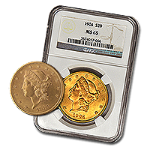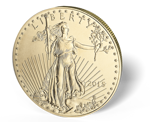The American Gold Eagle
The United States has a long history of minting gold coins. From 1795 to 1933, our nation’s gold coins were struck with the intent that they would be used as everyday circulating money. Minted in often-limited numbers in a variety of series and designs, they ranged from the tiny $1 to the massive $20. In 1933 these coins were recalled from public circulation by the Roosevelt Administration, which were then melted down by the Treasury Department. The massive stockpile of 400-ounce gold bricks in Fort Knox (Kentucky) is primarily composed of the gold recovered from our nation’s pre-1933 gold coins. Today the limited number of coins that survived the massive melting in the mid-1930s are valuable collector coins.
In 1985, in response to the worldwide popularity of South Africa’s and Canada’s gold bullion coins, and to help support our domestic mining industry, Congress passed the Bullion Coin Act of 1985. The law instructed the Treasury Department to begin producing and distributing non-circulating gold coins in a variety of sizes. By law, these coins must only contain gold from sources in America. Produced in large numbers, the American Eagle family of gold coins quickly became the investing world’s most popularly traded gold bullion coins.
The American Eagle Gold Coins Offered Different Varieties
The American Eagle family includes coins containing exactly 1/10, 1/4, 1/2, and 1 ounce of pure gold. To increase their strength and resistance to abrasions, their gold is blended with copper and silver to produce a final alloy that is 22-karat (91.66 percent) pure, and is also known as “crown gold” because of its introduction in England for gold crown coin manufacture in 1526 by Henry VIII.
On the front of the coin (called the “obverse” by collectors), is the “Striding Liberty” design created by sculptor Augustus Saint-Gaudens for the U.S. Mint in 1906. It was used on our nation’s circulating $20 gold coins from 1907 to 1933. From 1986 to 1991, the year of striking is indicated in Roman numerals. The Treasury Department ordered the U.S. Mint to indicate the year of striking in Arabic numerals starting in 1992.
The design on the back (or reverse,) was created by sculptor Miley Busiek, portrays a male eagle, bearing an olive branch winging its way back to the nest with the awaiting mate and her hatchlings. Also on the reverse are the coin’s pure gold content and its face value. The face value is included solely to meet our nation’s coinage laws.
Is it the Face Value or the Intrinsic Value that Counts?
Gold bullion coins are valued for their gold contents. In addition to this intrinsic value, the U.S. Mint charges its primary distributors a premium to cover the government’s minting and distribution costs. The symbolic denomination that appears on the coin’s reverse (sometimes called the coin’s “face value”) is used solely to indicate it is legal tender (lawful money) of the United States.
Two Government Guarantees From the U.S. Treasury
Every American Eagle gold bullion coin is guaranteed for its weight and pure gold content by the U.S. Treasury Department. This feature has helped the American Eagle become the most popular and most widely traded gold bullion coins in the world.
Where to Buy & Sell, It’s Your Choice
Produced in virtually unlimited numbers, the American Eagle gold coins are bought and sold in many thousands of locations, in the United States and around the world. Their government guarantees, widespread availability, and unrivaled worldwide recognition have produced a deep and liquid market.
Know Your Privacy Rights and Requirements
Today, many investors are concerned about their privacy. Unlike pre-1933 U.S. gold coins, which generate no 1099-B reporting form, the sale of certain bullion gold coins may require a government reporting form. We urge you to understand and obey all of our nation’s laws, including those relating to your investments.














